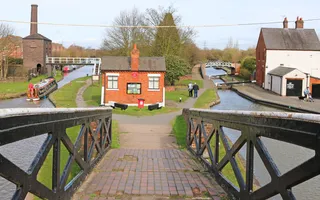Stroll along the Coventry Canal on this 5 mile walk from the canal basin to historic Hawkesbury Junction. The walk can be broken up into sections if you prefer a shorter route.
Canal: Coventry Canal
Start: Coventry Basin OS Grid ref: SP333796 Postcode: CV1 4LH
Finish: Hawkesbury Junction OS Grid ref: SP361845 Postcode: CV6 6DF
Distance: 8.8km / 5½ miles
Route instructions
Start: Coventry Canal Basin marks the start of the Coventry Canal. Wharves, a crane and restored warehouses which once stored grain, cement and foodstuffs are a reminder of its busy heyday. Look out for the former weighbridge office and the coal vaults (now an artistic hub). Prolific canal engineer James Brindley was commissioned to build the canal, but was shockingly sacked within a year for allegedly not devoting enough time. The first artwork on the Coventry Canal Art Trail, which runs all the way to Hawkesbury, is a bronze statue celebrating Brindley in action, toiling over papers on his desk.
1. Just beyond the café, follow the road up to cross the bridge and turn left to join the towpath.
2. Daimler Powerhouse Creation Centre opened in 2021 as an arts and culture hub. Originally a mill, Coventry's Daimler Building became world famous as the first car factory in Britain, and now continues its tradition of ingenuity and creativity. Next door, on the site of Coventry's first power station which operated from 1895 to 1972, is Electric Wharf.
3. Just beyond Cash's Lane Bridge 2, look out for a row of three-storey terraced houses, ‘Cash's Hundred Houses', on your left. Quaker brothers John and Joseph Cash ran a silk weaving company which built the now Grade II-listed houses for its weavers in 1857 (only 48 were ever built), creating a ‘cottage factory' which could compete with other companies using custom-built factories. A shared driveshaft ran through the upper floors, powered by a central steam engine, enabling home-based weavers to operate power looms.
4. Your surroundings become leafier and are dotted with artworks as the canal winds through Coventry's outskirts.
5. Look out for moored boats as the towpath crosses over the entrance to Stoke Heath Basin.
6. This was the original junction between the Coventry and Oxford Canals. The canal companies couldn't decide how to charge tolls along this stretch, so they built the canals side by side from here to Hawkesbury. Walking onwards, lush hedgerows and birdsong become the treat of this walk.
7. Colourful boats moored at Exhall Basin come into view and benches offer the perfect spot to watch ducks, moorhens and coots, and of course any boat action.
8. Hawkesbury Junction is where the Coventry and Oxford Canals finally part ways. An important link for over 200 years, it is still one of the busiest canal junctions in the country. A toll house, built in 1777 by the Coventry Canal Company, sits at its heart. Also known as Sutton's Stop, after Richard and Henry Sutton who were lock-keepers here between 1807 and 1876, the Junction is a designated Conservation Area, and most of its buildings and bridges are Grade II-listed.
The cast-iron bridge over the H-shaped junction spans 50ft and was built in 1837 for £630. It offers the perfect vantage point for you to watch boats manoeuvre the difficult 90-degree turn or work through the shallow lock.
The Greyhound Inn, built in 1825, used to provide food for boatmen and stabling for their horses. It is still renowned and much loved by today's boaters.
9. The Engine House pumped water to the canal from a local stream then later a deep well. The original 1725 steam engine, appropriately named ‘Lady Godiva', was installed in 1821 after almost 100 years at a nearby colliery and is now on display in Dartmouth, birthplace of its engineer Thomas Newcomen.
End: Amble back to the Basin, hop on a bus or explore further along either the Coventry or the Oxford.








